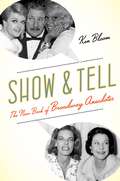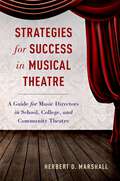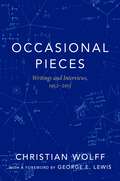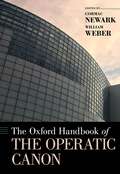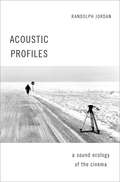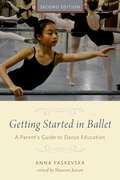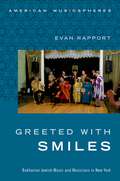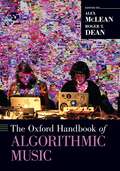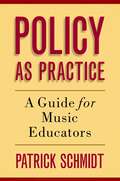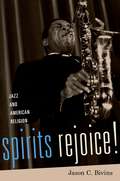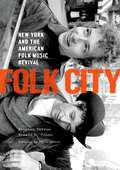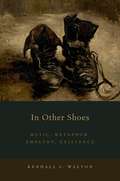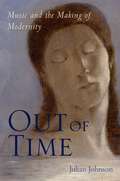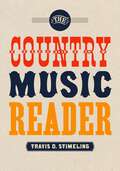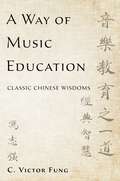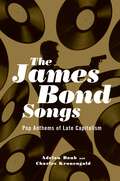- Table View
- List View
Show and Tell: The New Book of Broadway Anecdotes
by Ken BloomDid you know that Frank Sinatra was nearly considered for the original production of Fiddler on the Roof? Or that Jerome Robbins never choreographed the famous "Dance at the Gym" in West Side Story? Or that Lin-Manuel Miranda called out an audience member on Twitter for texting during a performance of Hamilton (the perpetrator was Madonna)? In Show and Tell: The New Book of Broadway Anecdotes, Broadway aficionado-in-chief Ken Bloom takes us on a spirited spin through some of the most intriguing factoids in show business, offering up an unconventional history of the theatre in all its idiosyncratic glory. From the cantankerous retorts of George Abbott to the literally show-stopping antics of Katharine Hepburn, you'll learn about the adventures and star turns of some of the Broadway's biggest personalities, and discover little-known tidbits about beloved plays and musicals from The Black Crook to Beautiful.
Show and Tell: The New Book of Broadway Anecdotes
by Ken BloomDid you know that Frank Sinatra was nearly considered for the original production of Fiddler on the Roof? Or that Jerome Robbins never choreographed the famous "Dance at the Gym" in West Side Story? Or that Lin-Manuel Miranda called out an audience member on Twitter for texting during a performance of Hamilton (the perpetrator was Madonna)? In Show and Tell: The New Book of Broadway Anecdotes, Broadway aficionado-in-chief Ken Bloom takes us on a spirited spin through some of the most intriguing factoids in show business, offering up an unconventional history of the theatre in all its idiosyncratic glory. From the cantankerous retorts of George Abbott to the literally show-stopping antics of Katharine Hepburn, you'll learn about the adventures and star turns of some of the Broadway's biggest personalities, and discover little-known tidbits about beloved plays and musicals from The Black Crook to Beautiful.
Strategies for Success in Musical Theatre: A Guide for Music Directors in School, College, and Community Theatre
by Herbert D. MarshallIn Strategies for Success in Musical Theatre, veteran musical director and teacher Herbert Marshall provides an essential how-to guide for teachers or community members who find themselves in charge of music directing a show. Stepping off the podium, Marshall offers practical and often humorous real-world advice on managing auditions; organizing rehearsals; working with a choir, choreographer, and leads; how to run a sitzprobe, a technical rehearsal, and a dress rehearsal; how to manage the cast and crew energy for a successful opening night; and ways to end the experience on a high note for all involved. Throughout the book, Marshall emphasizes the importance of learning through performance and the beauty of a group united in a common goal. In doing so, he turns what can appear as a never-ending list of tasks and demand for specialized knowledge into a manageable, educational, and ultimately engaging and fun experience for all. Because the techniques in Marshall's book have been thoroughly workshopped and classroom tested, they are based in proven pedagogy and will be of particular use for the music director in acting as a teaching director: someone imparting theatrical knowledge to his or her cast and production staff. Marshall provides both extended and abbreviated timelines, flexible to fit any director's needs. Marshall's book is a greatly beneficial resource for music education students and teachers alike, giving an insightful glimpse into the range of possibilities within a music educator's career. Musicians and actors with varying levels of skill and experience will be able to grow simultaneously through Marshall's innovative teaching plans. Through collaborative techniques, steps in the book serve to educate both director and student. Thoroughly illustrated with charts, diagrams, and scores, Strategies for Success in Musical Theatre is an ideal companion for all who work with school and community based musical theater productions.
STRATEG FOR SUCCESS IN MUS THEATRE C: A Guide for Music Directors in School, College, and Community Theatre
by Herbert D. MarshallIn Strategies for Success in Musical Theatre, veteran musical director and teacher Herbert Marshall provides an essential how-to guide for teachers or community members who find themselves in charge of music directing a show. Stepping off the podium, Marshall offers practical and often humorous real-world advice on managing auditions; organizing rehearsals; working with a choir, choreographer, and leads; how to run a sitzprobe, a technical rehearsal, and a dress rehearsal; how to manage the cast and crew energy for a successful opening night; and ways to end the experience on a high note for all involved. Throughout the book, Marshall emphasizes the importance of learning through performance and the beauty of a group united in a common goal. In doing so, he turns what can appear as a never-ending list of tasks and demand for specialized knowledge into a manageable, educational, and ultimately engaging and fun experience for all. Because the techniques in Marshall's book have been thoroughly workshopped and classroom tested, they are based in proven pedagogy and will be of particular use for the music director in acting as a teaching director: someone imparting theatrical knowledge to his or her cast and production staff. Marshall provides both extended and abbreviated timelines, flexible to fit any director's needs. Marshall's book is a greatly beneficial resource for music education students and teachers alike, giving an insightful glimpse into the range of possibilities within a music educator's career. Musicians and actors with varying levels of skill and experience will be able to grow simultaneously through Marshall's innovative teaching plans. Through collaborative techniques, steps in the book serve to educate both director and student. Thoroughly illustrated with charts, diagrams, and scores, Strategies for Success in Musical Theatre is an ideal companion for all who work with school and community based musical theater productions.
Occasional Pieces: Writings and Interviews, 1952-2013
by Christian WolffAs one of the original pioneering composers of the American experimental music movement and a well known scholar of classics, Christian Wolff has long been active as a significant thinker and elegant writer on music. With Occasional Pieces, Wolff brings together a collection of his most notable writings and interviews from 1950 to the present, shining a new light on American music of the second half of the twentieth century. The collection opens with some of his earliest writings on his craft, discussing his own proto-minimalist compositional procedures and the music and ideas that led him to develop these techniques. Organized chronologically to give a sense of the development of Wolff's thinking on music over the course of his career, some of the pieces delve into connections of music-making to social and political issues, and the concept of indeterminacy as it applies to performance, while others offer insights into the work of Wolff's notable contemporaries including John Cage, Morton Feldman, Earle Brown, David Tudor, Frederic Rzewski, Cornelius Cardew , Dieter Schnebel, Pauline Oliveros, and Merce Cunningham. An invaluable resource for historians, composers, listeners and students alike, Occasional Pieces offers a deep dive into Christian Wolff's musical world and brings new light to the history of the American experimental movement.
OCCASIONAL PIECES C: Writings and Interviews, 1952-2013
by Christian WolffAs one of the original pioneering composers of the American experimental music movement and a well known scholar of classics, Christian Wolff has long been active as a significant thinker and elegant writer on music. With Occasional Pieces, Wolff brings together a collection of his most notable writings and interviews from 1950 to the present, shining a new light on American music of the second half of the twentieth century. The collection opens with some of his earliest writings on his craft, discussing his own proto-minimalist compositional procedures and the music and ideas that led him to develop these techniques. Organized chronologically to give a sense of the development of Wolff's thinking on music over the course of his career, some of the pieces delve into connections of music-making to social and political issues, and the concept of indeterminacy as it applies to performance, while others offer insights into the work of Wolff's notable contemporaries including John Cage, Morton Feldman, Earle Brown, David Tudor, Frederic Rzewski, Cornelius Cardew , Dieter Schnebel, Pauline Oliveros, and Merce Cunningham. An invaluable resource for historians, composers, listeners and students alike, Occasional Pieces offers a deep dive into Christian Wolff's musical world and brings new light to the history of the American experimental movement.
The Oxford Handbook of the Operatic Canon (Oxford Handbooks)
Opera has always been a vital and complex mixture of commercial and aesthetic concerns, of bourgeois politics and elite privilege. In its long heyday in the eighteenth and nineteenth centuries, it came to occupy a special place not only among the arts but in urban planning, too this is, perhaps surprisingly, often still the case. The Oxford Handbook of the Operatic Canon examines how opera has become the concrete edifice it was never meant to be, by tracing its evolution from a market entirely driven by novelty to one of the most canonic art forms still in existence. Throughout the book, a lively assembly of musicologists, historians, and industry professionals tackle key questions of opera's past, present, and future. Why did its canon evolve so differently from that of concert music? Why do its top ten titles, all more than a century old, now account for nearly a quarter of all performances worldwide? Why is this system of production becoming still more top-heavy, even while the repertory seemingly expands, notably to include early music? Topics range from the seventeenth century to the present day, from Russia to England and continental Europe to the Americas. To reflect the contested nature of many of them, each is addressed in paired chapters. These complement each other in different ways: by treating the same geographical location in different periods, by providing different national or regional perspectives on the same period, or by thinking through similar conceptual issues in contrasting or changing contexts. Posing its questions in fresh, provocative terms, The Oxford Handbook of the Operatic Canon challenges scholarly assumptions in music and cultural history, and reinvigorates the dialogue with an industry that is, despite everything, still growing.
Acoustic Profiles: A Sound Ecology of the Cinema (OXFORD MUSIC/MEDIA SERIES)
by Randolph JordanIn Acoustic Profiles, author Randolph Jordan proposes a new model for image-sound analysis that incorporates the vocabulary and methods of environmental studies, specifically exploring the potential of a model based on acoustic ecology. Jordan uses close readings of films to connect the diverse fields of architecture, environmental studies, art history, the history of modernity, and media studies through the tenets of acoustic ecology. In relating ways of thinking about sound from acoustic ecology to film studies and vice versa, Acoustic Profiles takes an interdisciplinary approach to inspire readers to experience cinematic art as a motivator of greater environmental purposes and to understand the role of the media in achieving those purposes. The book's method is referred to as acoustic profiling, a theoretical tool for hearing how filmmakers articulate spatial dimensions in their works. To that end, the book demonstrates how the creative use of media technologies in different fields can be understood relationally through the ecological issues that connect them, revivifying acoustic ecology for media studies while broadening the latter's ecological scope. The book provides a tool kit for readers to hear films with new ears, to think critically about this new listening practice, and to extend that engagement beyond the walls of the screening room by opening works of audiovisual media up to the consideration of soundscape research.
Acoustic Profiles: A Sound Ecology of the Cinema (OXFORD MUSIC/MEDIA SERIES)
by Randolph JordanIn Acoustic Profiles, author Randolph Jordan proposes a new model for image-sound analysis that incorporates the vocabulary and methods of environmental studies, specifically exploring the potential of a model based on acoustic ecology. Jordan uses close readings of films to connect the diverse fields of architecture, environmental studies, art history, the history of modernity, and media studies through the tenets of acoustic ecology. In relating ways of thinking about sound from acoustic ecology to film studies and vice versa, Acoustic Profiles takes an interdisciplinary approach to inspire readers to experience cinematic art as a motivator of greater environmental purposes and to understand the role of the media in achieving those purposes. The book's method is referred to as acoustic profiling, a theoretical tool for hearing how filmmakers articulate spatial dimensions in their works. To that end, the book demonstrates how the creative use of media technologies in different fields can be understood relationally through the ecological issues that connect them, revivifying acoustic ecology for media studies while broadening the latter's ecological scope. The book provides a tool kit for readers to hear films with new ears, to think critically about this new listening practice, and to extend that engagement beyond the walls of the screening room by opening works of audiovisual media up to the consideration of soundscape research.
Getting Started in Ballet: A Parent's Guide to Dance Education
by Anna PaskevskaIn Getting Started in Ballet, A Parent's Guide to Dance Education, authors Anna Paskevska and Maureen Janson comprehensively present the realities that parents can anticipate during their child's training and/or career in ballet. It can be daunting and confusing when parents discover their child's desire to dance. Parental guidance and education about dance study typically comes from trial by fire. This book expertly guides the parental decision-making process by weaving practical advice together with useful information about dance history and the author's own memoir. From selecting a teacher in the early stages, to supporting a child through his or her choice to dance professionally, parents of prospective dancers are lead through a series of considerations, and encouraged to think carefully and to make wise decisions. Written primarily as a guide book for parents, it is just as useful for teachers, and this exemplary document would do well to have a place on the bookshelf in every dance studio waiting room. Not only can dance parents learn from this informative text, but dance teachers can be nudged toward a greater understanding and anticipation of parents needs and questions. Getting Started in Ballet fills a gap, conveniently under one cover, welcoming parents to regard every aspect of their child's possible future in dance. Without this book, there would be little documentation of the parenting aspect of dance. Dance is unlike any other training or field and knowing how to guide a young dancer can make or break them as a dancer or dance lover.
GETTING STARTED IN BALLET 2E C: A Parent's Guide to Dance Education
by Anna PaskevskaIn Getting Started in Ballet, A Parent's Guide to Dance Education, authors Anna Paskevska and Maureen Janson comprehensively present the realities that parents can anticipate during their child's training and/or career in ballet. It can be daunting and confusing when parents discover their child's desire to dance. Parental guidance and education about dance study typically comes from trial by fire. This book expertly guides the parental decision-making process by weaving practical advice together with useful information about dance history and the author's own memoir. From selecting a teacher in the early stages, to supporting a child through his or her choice to dance professionally, parents of prospective dancers are lead through a series of considerations, and encouraged to think carefully and to make wise decisions. Written primarily as a guide book for parents, it is just as useful for teachers, and this exemplary document would do well to have a place on the bookshelf in every dance studio waiting room. Not only can dance parents learn from this informative text, but dance teachers can be nudged toward a greater understanding and anticipation of parents needs and questions. Getting Started in Ballet fills a gap, conveniently under one cover, welcoming parents to regard every aspect of their child's possible future in dance. Without this book, there would be little documentation of the parenting aspect of dance. Dance is unlike any other training or field and knowing how to guide a young dancer can make or break them as a dancer or dance lover.
Greeted With Smiles: Bukharian Jewish Music and Musicians in New York (American Musicspheres)
by Evan RapportAs the Soviet Union stood on the brink of collapse, thousands of Bukharian Jews left their homes from across the predominantly Muslim cities of Central Asia, to reestablish their lives in the United States, Israel and Europe. Today, about thirty thousand Bukharian Jews reside in New York City, settled into close-knit communities and existing as a quintessential American immigrant group. For Bukharian immigrants, music is an essential part of their communal self-definition, and musicians frequently act as cultural representatives for the group as a whole. Greeted with Smiles: Bukharian Jewish Music and Musicians in New York explores the circumstances facing new American immigrants, using the music of the Bukharian Jews to gain entrance into their community and their culture. Author Evan Rapport investigates the transformation of Bukharian identity through an examination of corresponding changes in its music, focusing on three of these distinct but overlapping repertoires - maqom (classical or "heavy" music), Jewish religious music and popular party (or "light") music. Drawing upon interviews, participant observation and music lessons, Rapport interprets the personal perspectives of musicians who serve as community leaders and representatives. By adapting strategies acquired as an ethno-religious minority among Central Asian Muslim neighbors, Bukharian musicians have adjusted their musical repertoire in their new American home. The result is the creation of a distinct Bukharian Jewish American identity-their musical activities are changing the city's cultural landscape while at the same time providing for an understanding of the cultural implications of Bukharian diaspora. Greeted with Smiles is sure to be an essential text for ethnomusicologists and scholars of Jewish and Central Asian music and culture, Jewish-Muslim interaction and diasporic communities.
The Oxford Handbook of Algorithmic Music (Oxford Handbooks)
With the ongoing development of algorithmic composition programs and communities of practice expanding, algorithmic music faces a turning point. Joining dozens of emerging and established scholars alongside leading practitioners in the field, chapters in this Handbook both describe the state of algorithmic composition and also set the agenda for critical research on and analysis of algorithmic music. Organized into four sections, chapters explore the music's history, utility, community, politics, and potential for mass consumption. Contributors address such issues as the role of algorithms as co-performers, live coding practices, and discussions of the algorithmic culture as it currently exists and what it can potentially contribute society, education, and ecommerce. Chapters engage particularly with post-human perspectives - what new musics are now being found through algorithmic means which humans could not otherwise have made - and, in reciprocation, how algorithmic music is being assimilated back into human culture and what meanings it subsequently takes. Blending technical, artistic, cultural, and scientific viewpoints, this Handbook positions algorithmic music making as an essentially human activity.
Policy as Practice: A Guide for Music Educators
by Patrick SchmidtBoth in concept and in practice, policy has permeated the deepest recesses of civil society and has had particular impact on the lives of those who are actively connected to the educational process. For music teachers in particular, policy can evoke images of a forbidden environment beyond one's day-to-day duties and responsibilities. Nothing, however, could be farther from the truth. In this book, author Patrick Schmidt offers a variety of ways for K-12 music educators to engage with, analyze, and develop effective policy. Schmidt first demystifies the notion of policy and the characterization that it is out-of-reach to teachers, before exemplifying how policy, both big-picture policy and policy as a daily encounter enacted at the local level, share many similarities and are indeed co-dependent fragments of the same process. The first provides extensive and detailed contextual information, offering a conceptual vision for how to consider policy in the fast-pace and high-adaptability reality of 21st-century music education environments. The second delivers a practical set of ideas, guidelines, and suggestions specific to music education for a closer and more active interaction with policy, directed at providing 'tools for action' in the daily working lives of music educators. This approach enourages those who are novice to policy as well as those who would like to further explore and participate in policy action to exercise informed influence within their field, community, and school, and ultimately have greater impact in pedagogical, curricular, administrative, and legislative decision-making.
POLICY AS PRACTICE C: A Guide for Music Educators
by Patrick SchmidtBoth in concept and in practice, policy has permeated the deepest recesses of civil society and has had particular impact on the lives of those who are actively connected to the educational process. For music teachers in particular, policy can evoke images of a forbidden environment beyond one's day-to-day duties and responsibilities. Nothing, however, could be farther from the truth. In this book, author Patrick Schmidt offers a variety of ways for K-12 music educators to engage with, analyze, and develop effective policy. Schmidt first demystifies the notion of policy and the characterization that it is out-of-reach to teachers, before exemplifying how policy, both big-picture policy and policy as a daily encounter enacted at the local level, share many similarities and are indeed co-dependent fragments of the same process. The first provides extensive and detailed contextual information, offering a conceptual vision for how to consider policy in the fast-pace and high-adaptability reality of 21st-century music education environments. The second delivers a practical set of ideas, guidelines, and suggestions specific to music education for a closer and more active interaction with policy, directed at providing 'tools for action' in the daily working lives of music educators. This approach enourages those who are novice to policy as well as those who would like to further explore and participate in policy action to exercise informed influence within their field, community, and school, and ultimately have greater impact in pedagogical, curricular, administrative, and legislative decision-making.
Spirits Rejoice!: Jazz and American Religion
by Jason C. BivinsIn Spirits Rejoice! Jason Bivins explores the relationship between American religion and American music, and the places where religion and jazz have overlapped. Much writing about jazz tends toward glorified discographies or impressionistic descriptions of the actual sounds. Rather than providing a history, or series of biographical entries, Spirits Rejoice! takes to heart a central characteristic of jazz itself and improvises, generating a collection of themes, pursuits, reoccurring foci, and interpretations. Bivins riffs on interviews, liner notes, journals, audience reception, and critical commentary, producing a work that argues for the centrality of religious experiences to any legitimate understanding of jazz, while also suggesting that jazz opens up new interpretations of American religious history. Bivins examines themes such as musical creativity as related to specific religious traditions, jazz as a form of ritual and healing, and jazz cosmologies and metaphysics. Spirits Rejoice! connects Religious Studies to Jazz Studies through thematic portraits, and a vast number of interviews to propose a new, improvisationally fluid archive for thinking about religion, race, and sound in the United States. Bivins's conclusions explore how the sound of spirits rejoicing challenges not only prevailing understandings of race and music, but also the way we think about religion. Spirits Rejoice! is an essential volume for any student of jazz, American religion, or American culture.
Spirits Rejoice!: Jazz and American Religion
by Jason C. BivinsIn Spirits Rejoice! Jason Bivins explores the relationship between American religion and American music, and the places where religion and jazz have overlapped. Much writing about jazz tends toward glorified discographies or impressionistic descriptions of the actual sounds. Rather than providing a history, or series of biographical entries, Spirits Rejoice! takes to heart a central characteristic of jazz itself and improvises, generating a collection of themes, pursuits, reoccurring foci, and interpretations. Bivins riffs on interviews, liner notes, journals, audience reception, and critical commentary, producing a work that argues for the centrality of religious experiences to any legitimate understanding of jazz, while also suggesting that jazz opens up new interpretations of American religious history. Bivins examines themes such as musical creativity as related to specific religious traditions, jazz as a form of ritual and healing, and jazz cosmologies and metaphysics. Spirits Rejoice! connects Religious Studies to Jazz Studies through thematic portraits, and a vast number of interviews to propose a new, improvisationally fluid archive for thinking about religion, race, and sound in the United States. Bivins's conclusions explore how the sound of spirits rejoicing challenges not only prevailing understandings of race and music, but also the way we think about religion. Spirits Rejoice! is an essential volume for any student of jazz, American religion, or American culture.
Folk City: New York and the American Folk Music Revival
by Stephen Petrus Ronald D. CohenFrom Washington Square Park and the Gaslight Café to WNYC Radio and Folkways Records, New York City's cultural, artistic, and commercial assets helped to shape a distinctively urban breeding ground for the folk music revival of the 1950s and 60s. Folk City explores New York's central role in fueling the nationwide craze for folk music in postwar America. It involves the efforts of record company producers and executives, club owners, concert promoters, festival organizers, musicologists, agents and managers, editors and writers - and, of course, musicians and audiences. In Folk City, authors Stephen Petrus and Ron Cohen capture the exuberance of the times and introduce readers to a host of characters who brought a new style to the biggest audience in the history of popular music. Among the savvy New York entrepreneurs committed to promoting folk music were Izzy Young of the Folklore Center, Mike Porco of Gerde's Folk City, and John Hammond of Columbia Records. While these and other businessmen developed commercial networks for musicians, the performance venues provided the artists space to test their mettle. The authors portray Village coffee houses not simply as lively venues but as incubators of a burgeoning counterculture, where artists from diverse backgrounds honed their performance techniques and challenged social conventions. Accessible and engaging, fresh and provocative, rich in anecdotes and primary sources, Folk City is lavishly illustrated with images collected for the accompanying major exhibition at the Museum of the City of New York in 2015.
Folk City: New York and the American Folk Music Revival
by Ronald D. Cohen Stephen PetrusFrom Washington Square Park and the Gaslight Café to WNYC Radio and Folkways Records, New York City's cultural, artistic, and commercial assets helped to shape a distinctively urban breeding ground for the folk music revival of the 1950s and 60s. Folk City explores New York's central role in fueling the nationwide craze for folk music in postwar America. It involves the efforts of record company producers and executives, club owners, concert promoters, festival organizers, musicologists, agents and managers, editors and writers - and, of course, musicians and audiences. In Folk City, authors Stephen Petrus and Ron Cohen capture the exuberance of the times and introduce readers to a host of characters who brought a new style to the biggest audience in the history of popular music. Among the savvy New York entrepreneurs committed to promoting folk music were Izzy Young of the Folklore Center, Mike Porco of Gerde's Folk City, and John Hammond of Columbia Records. While these and other businessmen developed commercial networks for musicians, the performance venues provided the artists space to test their mettle. The authors portray Village coffee houses not simply as lively venues but as incubators of a burgeoning counterculture, where artists from diverse backgrounds honed their performance techniques and challenged social conventions. Accessible and engaging, fresh and provocative, rich in anecdotes and primary sources, Folk City is lavishly illustrated with images collected for the accompanying major exhibition at the Museum of the City of New York in 2015.
In Other Shoes: Music, Metaphor, Empathy, Existence
by Kendall L. WaltonIn fifteen essays-one new, two newly revised and expanded, three with new postscripts-Kendall L. Walton wrestles with philosophical issues concerning music, metaphor, empathy, existence, fiction, and expressiveness in the arts. These subjects are intertwined in striking and surprising ways. By exploring connections among them, appealing sometimes to notions of imagining oneself in shoes different from one's own, Walton creates a wide-ranging mosaic of innovative insights.
Out of Time: Music and the Making of Modernity
by Julian JohnsonWhat does music have to say about modernity? How can this apparently unworldly art tell us anything about modern life? In Out of Time, author Julian Johnson begins from the idea that it can, arguing that music renders an account of modernity from the inside, a history not of events but of sensibility, an archaeology of experience. If music is better understood from this broad perspective, our idea of modernity itself is also enriched by the specific insights of music. The result is a rehearing of modernity and a rethinking of music - an account that challenges ideas of linear progress and reconsiders the common concerns of music, old and new. If all music since 1600 is modern music, the similarities between Monteverdi and Schoenberg, Bach and Stravinsky, or Beethoven and Boulez, become far more significant than their obvious differences. Johnson elaborates this idea in relation to three related areas of experience - temporality, history and memory; space, place and technology; language, the body, and sound. Criss-crossing four centuries of Western culture, he moves between close readings of diverse musical examples (from the madrigal to electronic music) and drawing on the history of science and technology, literature, art, philosophy, and geography. Against the grain of chronology and the usual divisions of music history, Johnson proposes profound connections between musical works from quite different times and places. The multiple lines of the resulting map, similar to those of the London Underground, produce a bewildering network of plural connections, joining Stockhausen to Galileo, music printing to sound recording, the industrial revolution to motivic development, steam trains to waltzes. A significant and groundbreaking work, Out of Time is essential reading for anyone interested in the history of music and modernity.
Out of Time: Music and the Making of Modernity
by Julian JohnsonWhat does music have to say about modernity? How can this apparently unworldly art tell us anything about modern life? In Out of Time, author Julian Johnson begins from the idea that it can, arguing that music renders an account of modernity from the inside, a history not of events but of sensibility, an archaeology of experience. If music is better understood from this broad perspective, our idea of modernity itself is also enriched by the specific insights of music. The result is a rehearing of modernity and a rethinking of music - an account that challenges ideas of linear progress and reconsiders the common concerns of music, old and new. If all music since 1600 is modern music, the similarities between Monteverdi and Schoenberg, Bach and Stravinsky, or Beethoven and Boulez, become far more significant than their obvious differences. Johnson elaborates this idea in relation to three related areas of experience - temporality, history and memory; space, place and technology; language, the body, and sound. Criss-crossing four centuries of Western culture, he moves between close readings of diverse musical examples (from the madrigal to electronic music) and drawing on the history of science and technology, literature, art, philosophy, and geography. Against the grain of chronology and the usual divisions of music history, Johnson proposes profound connections between musical works from quite different times and places. The multiple lines of the resulting map, similar to those of the London Underground, produce a bewildering network of plural connections, joining Stockhausen to Galileo, music printing to sound recording, the industrial revolution to motivic development, steam trains to waltzes. A significant and groundbreaking work, Out of Time is essential reading for anyone interested in the history of music and modernity.
COUNTRY MUSIC READER C
by Travis D. StimelingIn The Country Music Reader Travis D. Stimeling provides an anthology of primary source readings from newspapers, magazines, and fan ephemera encompassing the history of country music from circa 1900 to the present. Presenting conversations that have shaped historical understandings of country music, it brings the voices of country artists and songwriters, music industry insiders, critics, and fans together in a vibrant conversation about a widely loved yet seldom studied genre of American popular music. Situating each source chronologically within its specific musical or cultural context, Stimeling traces the history of country music from the fiddle contests and ballad collections of the late nineteenth and early twentieth centuries through the most recent developments in contemporary country music. Drawing from a vast array of sources including popular magazines, fan newsletters, trade publications, and artist biographies, The Country Music Reader offers firsthand insight into the changing role of country music within both the music industry and American musical culture, and presents a rich resource for university students, popular music scholars, and country music fans alike.
A Way of Music Education: Classic Chinese Wisdoms
by C. Victor FungMoving back through Dewey, Heidegger, Nietzsche, and Rousseau, the lineage of Western music education finds its origins in Plato and Pythagoras. Yet theories not rooted in the ancient Greek tradition are all but absent. A Way of Music Education provides a much-needed intervention, integrating ancient Chinese thought into the canon of music education in a structured, systematized, and philosophical way. The book's three central sources - the Yijing (The Book of Changes), Confucianism, and Daoism - inform author C. Victor Fung's argument: that the human being exists as an entity at the center of an organismic world in which all things and events, including music and music education, are connected. Fung ultimately proposes a new educational philosophy based on three key ideas in Chinese thought: change, balance, and liberation. A unique work, A Way of Music Education offers a universal approach engrained in a specific and ancient cultural tradition.
The James Bond Songs: Pop Anthems of Late Capitalism
by Adrian Daub Charles KronengoldStarting with 1964's Goldfinger, every James Bond film has followed the same ritual, and so has its audience: after an exciting action sequence the screen goes black and the viewer spends three long minutes absorbing abstract opening credits and a song that sounds like it wants to return to 1964. In The James Bond Songs authors Adrian Daub and Charles Kronengold use the genre to trace not only a changing cultural landscape, but also evolving conceptions of what a pop song is. They argue that the story of the Bond song is the story of the pop song more generally, and perhaps even the story of its end. Each chapter discusses a particular segment of the Bond canon and contextualizes it in its era's music and culture. But the book also asks how Bond and his music reflected and influenced our feelings about such topics as masculinity, race, money, and aging. Through these individual pieces the book presents the Bond song as the perfect anthem of late capitalism. The Bond songs want to talk about the fulfillment that comes from fast cars, shaken Martinis and mindless sex, but their unstable speakers, subjects, and addressees actually undercut the logic of the lifestyle James Bond is sworn to defend. The book is an invitation to think critically about pop music, about genre, and about the political aspects of popular culture in the twentieth century and beyond.
